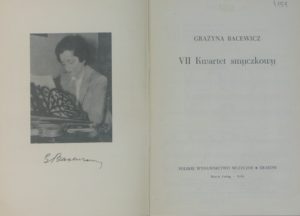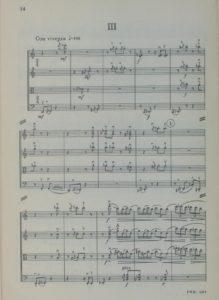- String Quartet no. 7, PWM score, title page
- String Quartet no. 7, PWM score, mov. 1
- String Quartet no. 7, PWM score, mov. 2
- String Quartet no. 7, PWM score, mov. 3
String Quartet No. 7 was written in 1965, a year marked by many achievements in the composer’s life: she wrote, among others, Violin Concerto No. 7, Piano Quintet No. 2, Musica sinfonica in tre movimenti and Divertimento for string orchestra.
Grażyna Bacewicz’s seventh and last quartet is one of the finest examples of the use in her oeuvre of “pure sound technique”, to use Józef Chomiński’s term, rooted, however, in tradition, which “tames” the sonic wealth within the framework of a classically constructed form.
Elements that stand out in the first movement (Allegro) are two thematic planes with distinctive textural physiognomies. The first is made up of several fleeting episodes with varied, polyphonic articulation. Here is the beginning of the piece: the viola, repeating the note B saltando in a sextolet, is accompanied by short tremolos of the first violin, cello chords played sul tasto – gettato, as well as pizzicato chords in the second violin, with everything being “scattered” across the sound space. A different form can be found in a fragment based on progressive, fast repetition of a three-note motif on the steps of a descending scale (sul ponticello). There emerges a passage in which, through its speed and the similarity of successive sound cells, the distinctiveness of the various notes is blurred, a phenomenon accurately described by Steffen Wittig in his analysis of the transformation of interval scales into colour qualities [Steffen Wittig, “Aspekte der Klangfarbe in den Werken der letzen Schaffensperiode Grażyna Bacewiczs (1960–1969)”, Łódź 1996]. The form of the second theme (Meno mosso) is more continuous, with elements of imitation. The material of this fragment can be treated as a textural variant of the Narrazione theme from the Quartet for Four Cellos composed one year before. This is an example of material integration, characteristic especially of the last period in the composer’s oeuvre. Imitative voices of both violins and the cello are accompanied by sequences with a trill and short glissandos in the viola. A fragment which can be called a recapitulation features successive elements of the second and first theme. The whole ends with short glissando saltando phrases which constituted elements of the first theme.
Unlike the sophisticated first movement, the second movement (Grave) is very expressive, at times even dramatic. What stands out here is a viola solo, a kind of a song spun against a changing background of the other instruments. The middle fragment features all kinds of ostinatos and interval scales. Towards the end we hear a brief return of the viola’s “song”, limited to a small ambitus. The ending is as unexpected as it is extraordinarily dramatic. After a sequence of the note D repeated by the cello (col legno, diminuendo) and long held notes of the other instruments, there emerges a collective “shout” (without the cello) in the form of a repeated and held chord (forte). The following fragment, Grandioso, filled with a passage of sharp chords appearing twice sounds like a cry of despair because of its intensity.
The third movement (Con vivezza) is marked by a return of cheerful mood, although there are moments of seriousness here as well. The tone of the whole is set by a “twittering” refrain consisting of a series of scattered single or repeated notes, also in the form of flageolets preceded by a grace note. The various episodes are characterised by articulation polyphony, when, for example, flageolet repeated figures of the second violin are accompanied by a trill of the first violin, viola motifs played pizzicato and a melodic phrase of the cello marked dolce. In calmer episodes, marked meno mosso, a melodic line emerges from the agitated sound matter, creating, together with the other voices, a semblance of imitation over a short section. The “twittering” refrain recurs several times, making the whole resemble a rondo.
The sonoristic virtuosity presented by Grażyna Bacewicz in String Quartet No. 7 was admired by Witold Lutosławski, who in an obituary after the composer’s death [Ruch Muzyczny 1969, no. 7] wrote:
Her style passed through various developmental stages and in the last period, when the latest achievements of the compositional technique came to the fore in it, it struck – as if in passing – a forgotten string, which had sounded already […] in her youthful Stained-Glass Window. I hear it in the extraordinarily subtle sonoristics of Quartet No. 7, which provides new testimony to the existence of many, hitherto unexpected, possibilities hidden in this seemingly well-known line-up. Few composers since Bartók have managed to penetrate the mysteries of the quartet texture to the same degree as Grażyna.
A slightly different approach to the phenomenon of Quartet No. 7 was presented by the musicologist Gražina Daunoravičiené [“Analityczna dygresja na temat VII Kwartetu smyczkowego Grażyny Bacewicz”, Vilnius 1997], writing that
it is a play of aristocratically subtle colours and hues of the string timbre, shimmering articulations and rhythms, as well as a sonorous reflection of a personality that is not overbearing, does not flatter, is dignified, ironic and at the same time fragile and feminine.
- String Quartet no. 7, manuscript (Music Department, Warsaw University Library), title page
- String Quartet no. 7, manuscript (Music Department, Warsaw University Library), p. 1
- String Quartet no. 7, manuscript (Music Department, Warsaw University Library), p. 2






